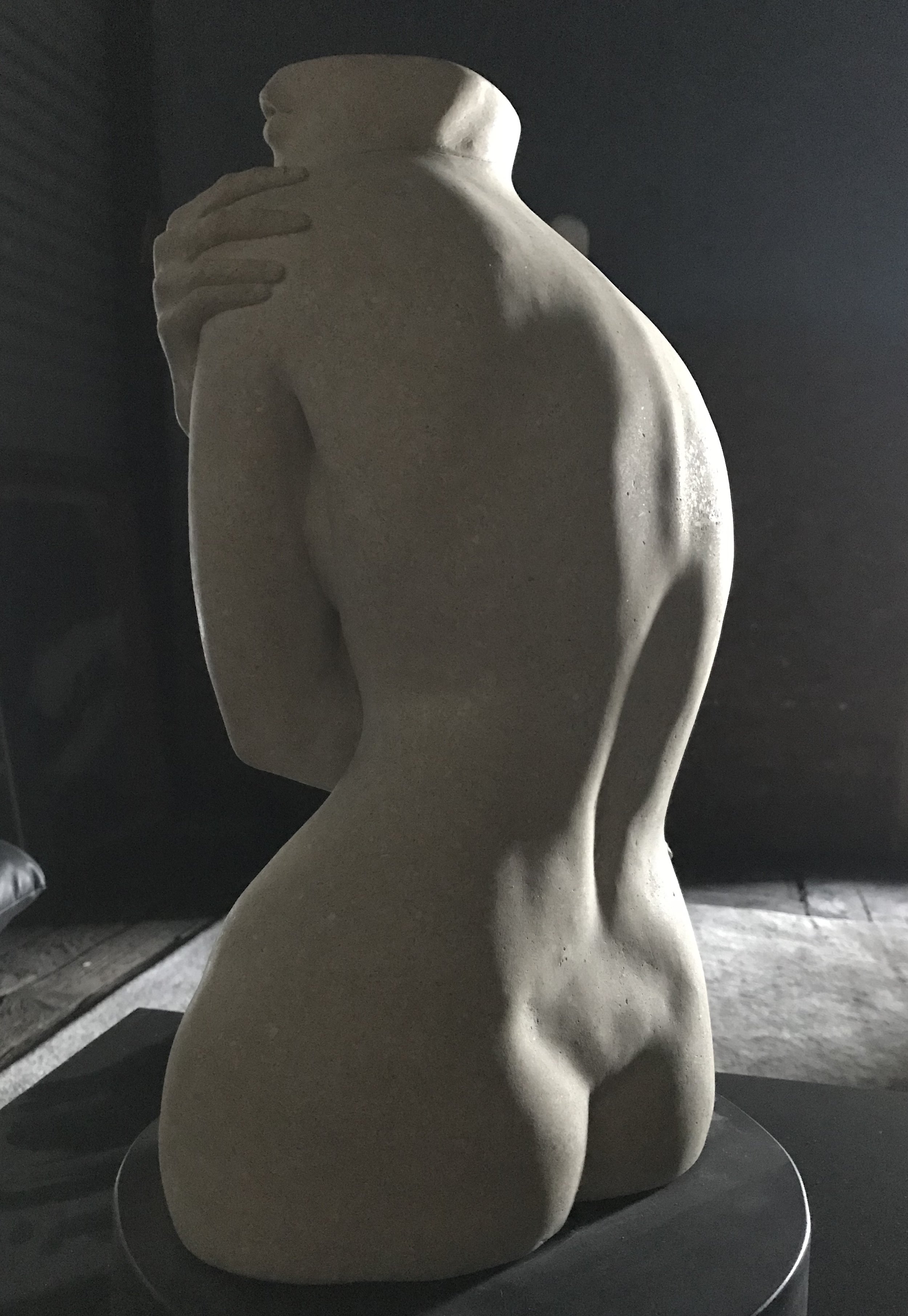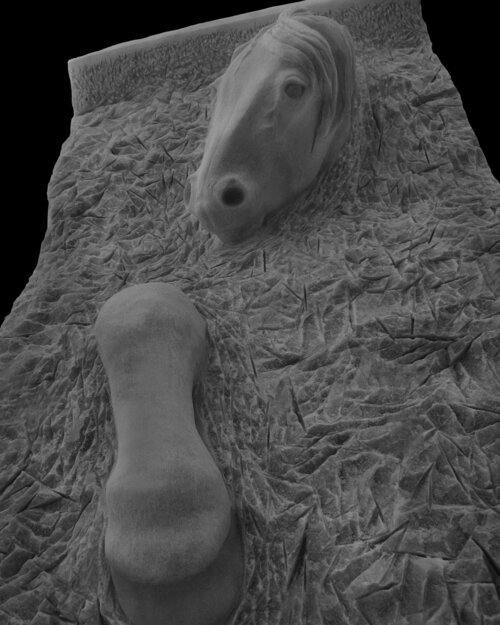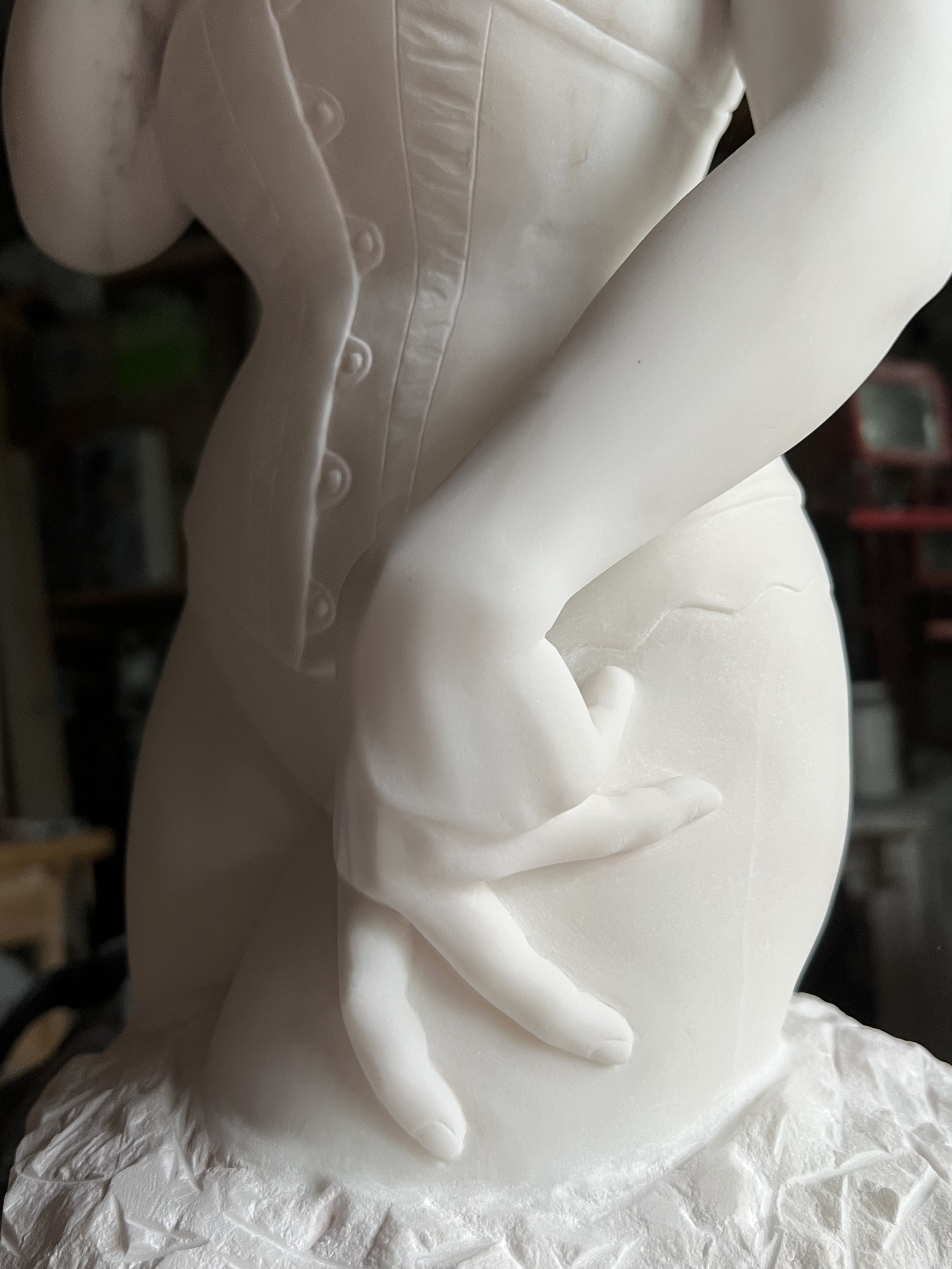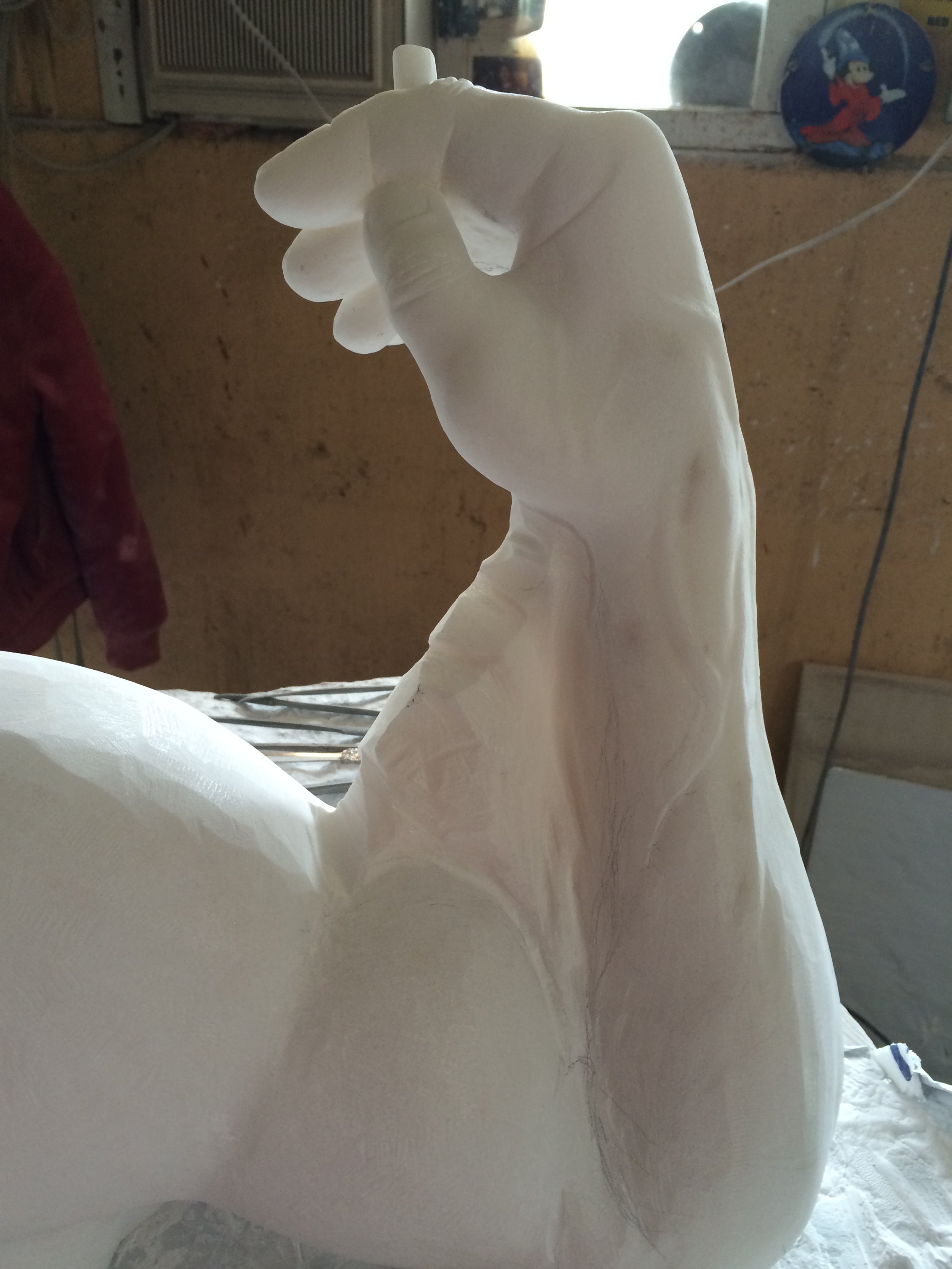Artist Sherry Tipton
Congratulations to Sherry Tipton for earning her place as a finalist in the 6th Edition!
Who are you?
I was born in Texas and raised in Oklahoma, an odd-ball only child who started drawing when she was three, reading at the age of four and piano lessons at five. No matter how hard I tried, fitting in was difficult. For example, I couldn't understand why, in second grade at our all-school drawing competition, everybody was laughing at my entry, which was an anatomically accurate rendering of a male horse. (I won anyway) Also, I played classical piano and bassoon, which isn't exactly normal and caused me to use words like "repertoire" much to the disgust of fellow students.
Suffice it to say that home life was toxic and for escape, I turned to music, horses and drawing. I married my high school boyfriend and raised two children in Boulder, CO, before finally realizing that I needed to make some major changes in my life. By chance, I signed up for a stone carving workshop and was instantly hooked.
“Annabelle” (Finalist Winning Work)
Italian marble, 18"x12"x12" approx.
Depiction a dear friend in her bespoke corset
By Sherry Tipton
What inspired you to begin utilizing first drawing then sculpture as a medium?
From the beginning, I drew the figure and worked hard to make flat images appear three-dimensional. In my twenties a gallery owner and friend mentioned that he thought I would begin sculpting at some point, thus planting the seed. Many years later, by chance, I signed up for a stone carving workshop and was captivated by it. I attended another workshop where I met my teacher and now husband, Ted Fleming. Stone carvers are primarily male and many of them didn't work very hard to hide their disrespect and I understand why. The tools are dangerous, it's loud and dirty, very hard on the body and requires a fair amount of physical strength. Most believed I'd give up within a year, but here I still am.
A lifetime of drawing made the transition to stone much easier for me. Instead of working with clay, (which I truly dislike and basically skipped altogether) I went straight to stone and do much less prep work than is typical.
“Embrace”
Indiana Limestone
21"x12"x9"
This piece is about internal gaze, with the back, the belly and the shoulders all curving inward. It expresses the process of introspection, self-acceptance and learning to love oneself.
By Sherry Tipton
What drew you to explore the human figure as a subject matter?
The figure has always been compelling to me. No other form speaks to me like the human face and body. This is so fundamental, it's like trying to explain why I blink my eyes. I love recreating the gorgeous lines and forms of the body, each one unique. We are programmed to recognize the smallest physical cues in each other and the depiction of this subtle physical language fascinates me- how the whole expression changes when I carve a tiny shadow under the corner of a lip, or vice versa, the tilt of the head, the tendons in the neck expressing tension or relaxation.
“Iqqios”
Turkish Afyon marble
Approximately 6' x 3' x 20"
carved in the land of the ancient Hittites They were the world's first great horsemen, creating many training techniques and inventing the chariot. Iqquios is the Hittite word for "horse" and my horse is breaking free from a wall of stone. In hindsight, perhaps it was the first of the "Bound Angels" series, since it introduces the common theme of the struggle for freedom.
By Sherry Tipton
Can you discuss the inspiration and thought process behind "Annabelle"?
A few years ago I was invited to the opening of a new bespoke corset shop in New Orleans. At the party, I was amazed by the women I met. They were beautiful, independent, strong and supportive in ways that I had never seen before. Like many, I had negative ideas of corsetry being forced on Victorian women, like so many other constraints put on women's attire. I saw it as just one more painful, restrictive social harness to control us. But that night I saw women doing exactly what they wanted and saw how empowered they looked when they emerged from the dressing room in a new corset. Every single one strutted with serious new attitude when they went from average to curvy goddess.
Don't get me wrong, corsets have been imposed on women a lot, along with many other opinions about what we can and can not wear. But that night I saw another side and it surprised me. Why are people always trying to tell us what to wear? "Annabelle" gets quite a few negative remarks online. Recently I was chided because the commenter said that the piece made her uncomfortable and isn't helpful given the state of women's rights now. She was making the assumption that Annabelle is corseted against her will. Perhaps. Perhaps not. (I know for a fact not, but that's beside the point) Once again, even if she thinks she's helping, the commenter is judging without relevant information and trying to dictate what Annabelle should wear. Or rather, not wear.
For me, this piece is about both sides of the story. Yes, I see it as representing the myriad of ways women have been shackled and restrained for centuries. And this oppression is re-emerging with a vengeance now. So if that commenter sees this in my sculpture, I'm happy. I succeeded in illustrating women's situation which should be disturbing. On the other hand, whatever a woman wants to wear that makes her feel good about herself (from corsets, leather, and silk to baggy sweats and t-shirts) and isn't hurting anybody else, then she should be free to do so without judgement.
The other interesting thing for me is how the corset moulds the body and distorts the shape.
“Sovereign”
Colorado Yule Marble
36"x16"x18"
A woman complete in herself, comfortable in her own skin. Not defined by her relationships with others. Again, I made a whole slideshow with all angles and details, but it won't load.
By Sherry Tipton
Can you walk us through the physical creation of "Annabelle"?
The first phase of my stone carving process is, after some loose sketches, laying out the design to scale on graph paper. Knowing how the piece will fit into the stone is very important. I find the centre lines from top to bottom on the stone and measure everything so I know exactly how everything will fit. Then I start rough cutting the large sections of stone with an angle grinder equipped with a diamond blade. This is an exceptionally scary and dangerous tool that requires great care while operating. Many stone carvers have some pretty impressive grinder scars, but the tool is so good that we all take the risk anyway. After the bulk is removed, I work with finer and finer tools like air hammers, die grinders, rotary tools and finally hand tools, some of which are as fine as dental instruments. The detail work on "Annabelle" was more intricate than any I've ever done before and it took many months to achieve the look of the seaming on the front of the corset, the front closures and the back lacing. Both hands are in highly unusual positions, which was challenging.
How would you describe your work?
My work, both sculpture and 2-dimensional pieces, is a combination of precise realism and artistic license. The basis for every piece is line. There must be beautiful line, without which a piece has no energy. I will tweak a pose to create or enhance this flow, but it needs to be done subtly, to avoid a melodramatic look. As I said before, all my work is figurative, sometimes the figure being equine. Although most depict women, I enjoy drawing and sculpting men, too.
Can you talk about your biggest learning experience during the process of creating your sculptures?
One of my biggest lessons was one I learned from my sculptor/architect husband, Ted. He is meticulous in every aspect of his work, be it a sculpture or designing a building. I go with my gut, which is one thing when working with pencils or pastels, but another thing altogether in the unforgiving medium of stone. There are some instances where artistic license needs to come second after precision. For example, hands, require correct measurement and alignment or they'll look broken or arthritic. Ted and I both love carving hands, and he taught me how to stop and take the time for accurate measurements, making sure joints and tendons all line up like they're supposed to.
Another big lesson for me was learning about tools. I had never worked with them before. Many stone carvers are men who have a lifetime of experience using tools for building, etc. but I had a lot to learn about every aspect of using them, safety, etc. I also had a lot to learn about stones. For instance, if you strike marble in the wrong way, it will bruise, almost like flesh bruises, because you have destroyed the gorgeous crystal structure that took literally thousands of millennia to create.
Can you discuss your biggest success since starting your artistic journey?
You can probably count on your fingers the number of women in the world who do direct figurative stone carving and have fingers left over. I am very proud to be one of them. Stone carving is the oldest art form, and presents unique challenges in the difficulty, the physical danger and the fact that if you take off stone where you shouldn't have, there's no erasing or painting over to correct the mistake. My greatest success is that I didn't give up and have created some pieces that are beautiful and that I am proud of. Sometimes I look at them and can not believe I did that. My sculptures will still be beautiful when I am long gone. I won't say I've completely mastered the carving of stone because there is always much more to learn. Learning this challenging art form has been a struggle, at times scary for me.
What projects are you working on currently? Can you discuss them?
I am planning to be in Turkey for a month-long symposium where I will create a monumental piece, yet to be designed. I have been commissioned to do a portrait bust of the poet-laureate of San Francisco, Jack Hirschman, who passed last summer and I have some smaller pieces in the studio which are close to finished, one of which is of my husband's arm and hand holding a cigarette stub.
What is your dream project or piece you hope to accomplish?
I have been dreaming of a monumental statue of Gaia, the base of which would be the crust of marble that has been exposed for centuries and is black and covered with lichen and moss. This would gradually give way to prehistoric creatures the bodies of which the marble is composed, then to more modern sea and land creatures, presided over by a glorious, gleaming white Gaia Goddess. I think it wants to be about 15' tall, so working with a team would help immensely.
“Dreamer”
Italian Marble
15"x6"x6"
A study of the face of an African-American woman, with closed eyes, dreaming up the new world she is creating
By Sherry Tipton
Lastly, I like to ask everyone what advice they would give to their fellow artists/photographers, what is your advice?
Developing your artist's eye is essential and the best way I know to do that is to draw. Regular practice on your own or with a class or group will sharpen your ability to see what is actually there. Also, the study of anatomy for figurative artists helps immensely, even if you're going to abstract the figure since you will have a better idea of the starting point. And finally, know thyself. Figure out what compels you and what you have to say about it and work from there.
To view more of Sherry Tipton’s work











